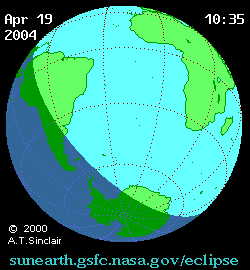| Solar eclipse of April 19, 2004 | |
|---|---|
| Type of eclipse | |
| Nature | Partial |
| Gamma | −1.1335 |
| Magnitude | 0.7367 |
| Maximum eclipse | |
| Coordinates | 61°36′S 44°18′E / 61.6°S 44.3°E |
| Times (UTC) | |
| Greatest eclipse | 13:35:05 |
| References | |
| Saros | 119 (65 of 71) |
| Catalog # (SE5000) | 9517 |
A partial solar eclipse occurred at the Moon's ascending node of orbit on Monday, April 19, 2004,[1][2] with a magnitude of 0.7367. A solar eclipse occurs when the Moon passes between Earth and the Sun, thereby totally or partly obscuring the image of the Sun for a viewer on Earth. A partial solar eclipse occurs in the polar regions of the Earth when the center of the Moon's shadow misses the Earth. It was largely visible over the south Atlantic Ocean and north shores of Antarctica, most prominently the Antarctic Peninsula.
The eclipse could also be seen in southern Africa at sunset. Considering the magnitude and the solar altitude, South Africa was the best place to observe this eclipse. In Cape Town, the Sun was about 40% obscured, while in Pretoria the Sun was 29% obscured. Further north, the eclipse remained visible up to Angola, southern DR Congo and Tanzania.
Images
[edit]Related eclipses
[edit]Eclipses of 2004
[edit]- A partial solar eclipse on April 19.
- A total lunar eclipse on May 4.
- A partial solar eclipse on October 14.
- A total lunar eclipse on October 28.
Metonic
[edit]- Preceded by: Solar eclipse of July 1, 2000
- Followed by: Solar eclipse of February 7, 2008
Tzolkinex
[edit]- Preceded by: Solar eclipse of March 9, 1997
- Followed by: Solar eclipse of June 1, 2011
Half-Saros
[edit]- Preceded by: Lunar eclipse of April 15, 1995
- Followed by: Lunar eclipse of April 25, 2013
Tritos
[edit]- Preceded by: Solar eclipse of May 21, 1993
- Followed by: Solar eclipse of March 20, 2015
Solar Saros 152
[edit]- Preceded by: Solar eclipse of April 9, 1986
- Followed by: Solar eclipse of April 30, 2022
Inex
[edit]- Preceded by: Solar eclipse of May 11, 1975
- Followed by: Solar eclipse of March 30, 2033
Triad
[edit]- Preceded by: Solar eclipse of June 19, 1917
- Followed by: Solar eclipse of February 18, 2091
Solar eclipses of 2004–2007
[edit]This eclipse is a member of a semester series. An eclipse in a semester series of solar eclipses repeats approximately every 177 days and 4 hours (a semester) at alternating nodes of the Moon's orbit.[3]
| Solar eclipse series sets from 2004 to 2007 | ||||||
|---|---|---|---|---|---|---|
| Ascending node | Descending node | |||||
| Saros | Map | Gamma | Saros | Map | Gamma | |
| 119 | April 19, 2004 Partial |
−1.13345 | 124 | October 14, 2004 Partial |
1.03481 | |
129 Partial in Naiguatá, Venezuela |
April 8, 2005 Hybrid |
−0.34733 | 134 Annularity in Madrid, Spain |
October 3, 2005 Annular |
0.33058 | |
139 Totality in Side, Turkey |
March 29, 2006 Total |
0.38433 | 144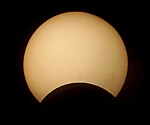 Partial in São Paulo, Brazil |
September 22, 2006 Annular |
−0.40624 | |
149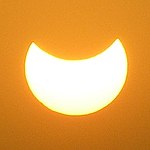 Partial in Jaipur, India |
March 19, 2007 Partial |
1.07277 | 154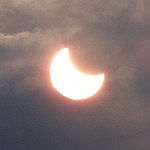 Partial in Córdoba, Argentina |
September 11, 2007 Partial |
−1.12552 | |
Saros 119
[edit]This eclipse is a part of Saros series 119, repeating every 18 years, 11 days, and containing 71 events. The series started with a partial solar eclipse on May 15, 850 AD. It contains total eclipses on August 9, 994 AD and August 20, 1012; a hybrid eclipse on August 31, 1030; and annular eclipses from September 10, 1048 through March 18, 1950. The series ends at member 71 as a partial eclipse on June 24, 2112. Its eclipses are tabulated in three columns; every third eclipse in the same column is one exeligmos apart, so they all cast shadows over approximately the same parts of the Earth.
The longest duration of totality was produced by member 10 at 32 seconds on August 20, 1012, and the longest duration of annularity was produced by member 44 at 7 minutes, 37 seconds on September 1, 1625. All eclipses in this series occur at the Moon’s ascending node of orbit.[4]
| Series members 54–71 occur between 1801 and 2112: | ||
|---|---|---|
| 54 | 55 | 56 |
 December 21, 1805 |
 January 1, 1824 |
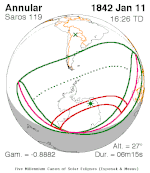 January 11, 1842 |
| 57 | 58 | 59 |
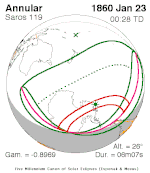 January 23, 1860 |
 February 2, 1878 |
 February 13, 1896 |
| 60 | 61 | 62 |
 February 25, 1914 |
 March 7, 1932 |
 March 18, 1950 |
| 63 | 64 | 65 |
 March 28, 1968 |
 April 9, 1986 |
 April 19, 2004 |
| 66 | 67 | 68 |
 April 30, 2022 |
 May 11, 2040 |
 May 22, 2058 |
| 69 | 70 | 71 |
 June 1, 2076 |
 June 13, 2094 |
 June 24, 2112 |
Tritos series
[edit]This eclipse is a part of a tritos cycle, repeating at alternating nodes every 135 synodic months (≈ 3986.63 days, or 11 years minus 1 month). Their appearance and longitude are irregular due to a lack of synchronization with the anomalistic month (period of perigee), but groupings of 3 tritos cycles (≈ 33 years minus 3 months) come close (≈ 434.044 anomalistic months), so eclipses are similar in these groupings.
The partial solar eclipses on March 27, 1884 (part of Saros 108) and December 24, 1916 (part of Saros 111) are also a part of this series but are not included in the table below.
| Series members between 1971 and 2200 | ||||
|---|---|---|---|---|
 July 22, 1971 (Saros 116) |
 June 21, 1982 (Saros 117) |
 May 21, 1993 (Saros 118) |
 April 19, 2004 (Saros 119) |
 March 20, 2015 (Saros 120) |
 February 17, 2026 (Saros 121) |
 January 16, 2037 (Saros 122) |
 December 16, 2047 (Saros 123) |
 November 16, 2058 (Saros 124) |
 October 15, 2069 (Saros 125) |
 September 13, 2080 (Saros 126) |
 August 15, 2091 (Saros 127) |
 July 15, 2102 (Saros 128) |
 June 13, 2113 (Saros 129) |
 May 14, 2124 (Saros 130) |
 April 13, 2135 (Saros 131) |
 March 12, 2146 (Saros 132) |
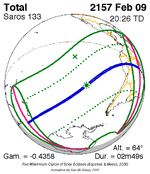 February 9, 2157 (Saros 133) |
 January 10, 2168 (Saros 134) |
 December 9, 2178 (Saros 135) |
 November 8, 2189 (Saros 136) |
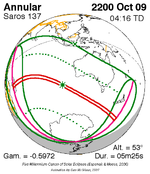 October 9, 2200 (Saros 137) | |||
Metonic series
[edit]The metonic series repeats eclipses every 19 years (6939.69 days), lasting about 5 cycles. Eclipses occur in nearly the same calendar date. In addition, the octon subseries repeats 1/5 of that or every 3.8 years (1387.94 days). All eclipses in this table occur at the Moon's ascending node.
| 21 eclipse events between July 1, 2000 and July 1, 2076 | ||||
|---|---|---|---|---|
| July 1–2 | April 19–20 | February 5–7 | November 24–25 | September 12–13 |
| 117 | 119 | 121 | 123 | 125 |
 July 1, 2000 |
 April 19, 2004 |
 February 7, 2008 |
 November 25, 2011 |
 September 13, 2015 |
| 127 | 129 | 131 | 133 | 135 |
 July 2, 2019 |
 April 20, 2023 |
 February 6, 2027 |
 November 25, 2030 |
 September 12, 2034 |
| 137 | 139 | 141 | 143 | 145 |
 July 2, 2038 |
 April 20, 2042 |
 February 5, 2046 |
 November 25, 2049 |
 September 12, 2053 |
| 147 | 149 | 151 | 153 | 155 |
 July 1, 2057 |
 April 20, 2061 |
 February 5, 2065 |
 November 24, 2068 |
 September 12, 2072 |
| 157 | ||||
 July 1, 2076 | ||||
References
[edit]- ^ "Sky". The Desert Sun. 2004-04-19. p. 32. Retrieved 2023-10-25 – via Newspapers.com.
- ^ "The stars". Poughkeepsie Journal. 2004-04-19. p. 2B. Retrieved 2023-10-25 – via Newspapers.com.
- ^ van Gent, R.H. "Solar- and Lunar-Eclipse Predictions from Antiquity to the Present". A Catalogue of Eclipse Cycles. Utrecht University. Retrieved 6 October 2018.
- ^ "NASA - Catalog of Solar Eclipses of Saros 119". eclipse.gsfc.nasa.gov.

